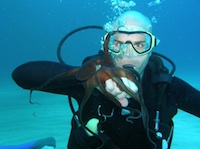Takeaways from The NSTA Convention – Part 1
 The National Science Teachers Association annual convention is a 4-day exhibition of the latest and greatest in science teaching. From workshops and presentations (the details of which fill a phonebook-sized guide!) to an exhibit hall packed with vendors and exhibitors, I always find the convention to be a wealth of information and ideas. In this series of posts, I’ll be sharing my favorite takeaways from the 2013 event.
The National Science Teachers Association annual convention is a 4-day exhibition of the latest and greatest in science teaching. From workshops and presentations (the details of which fill a phonebook-sized guide!) to an exhibit hall packed with vendors and exhibitors, I always find the convention to be a wealth of information and ideas. In this series of posts, I’ll be sharing my favorite takeaways from the 2013 event.

At the tinkering and making events I’ve attended over the past several years, I’ve heard countless people share how they’ve used Arduino both in their own projects and in the classroom. Arduino is an open-source micro-controller (think small computer chip with sensors and LEDs) that are programmable with a C++ esque language. At a workshop offered by exhibitor SparkFun Electronics, I had my first opportunity to play in Arduino. Within minutes, I was programming an RGB LED to blink in different colors in response to different light levels detected by a built-in light sensor on the board. I believe the incredible potential for Arduino in the classroom lies in its being easy to get started using while still having incredible potential for advanced projects. As with any computer programming implementation in the classroom, SparkFun and Arduino offer opportunities for students to develop critical thinking and problem solving skills.
 While incredibly easy to pick up, the Arduino programming language may challenging for younger students – I’d readily teach it to my 6th grade students but I am concerned that the syntax might not be accessible to the 3rd and 4th grade students I’ll be teaching in a maker camp this summer. Enter the SparkFun PicoBoard – an external board and set of sensors that interface with Scratch, the visual programming software developed by MIT. Instead of having to write code, programmers drag programming blocks into chains to create and control animated “sprites.” For example, a student might create an animated cat that closes its eyes when lights in the room are too bright or that runs off the screen when it hears a loud sound (light and sound are sensed by the PicoBoard – readings are then used to control the on-screen animation). I’d recommend starting by playing around with the free Scratch software (version 2.0 to be released soon!) and then adding a PicoBoard when you and your are ready for more complicated programming and animating.
While incredibly easy to pick up, the Arduino programming language may challenging for younger students – I’d readily teach it to my 6th grade students but I am concerned that the syntax might not be accessible to the 3rd and 4th grade students I’ll be teaching in a maker camp this summer. Enter the SparkFun PicoBoard – an external board and set of sensors that interface with Scratch, the visual programming software developed by MIT. Instead of having to write code, programmers drag programming blocks into chains to create and control animated “sprites.” For example, a student might create an animated cat that closes its eyes when lights in the room are too bright or that runs off the screen when it hears a loud sound (light and sound are sensed by the PicoBoard – readings are then used to control the on-screen animation). I’d recommend starting by playing around with the free Scratch software (version 2.0 to be released soon!) and then adding a PicoBoard when you and your are ready for more complicated programming and animating.
More updates from the NSTA Convention to follow. Stay tuned!
Full disclosure: I received a free SparkFun ProtoSnap as an attendee of their NSTA Workshop. I was under no obligation to use or review this product and receive no compensation from SparkFun for this posting or for any of the links included in this blog.”
